Evaluating Strategic Management: Stakeholder, Dynamic, Sustainable
VerifiedAdded on 2023/06/11
|13
|3165
|183
Report
AI Summary
This report explores alternative strategic management approaches, focusing on the stakeholder approach, dynamic capabilities, and sustainable strategies. It discusses the benefits, implementation issues, and limitations of each approach, providing examples of companies that have utilized them. The stakeholder approach emphasizes prioritizing stakeholder needs and gaining a competitive advantage ethically. Dynamic capabilities focus on reintegrating business models based on changes in the business environment. The sustainable approach emphasizes ethical means to attain sustainability. The report concludes by highlighting the viability of each approach in different contexts, considering both short-term and long-term goals of business enterprises. Desklib provides access to similar reports and study resources for students.
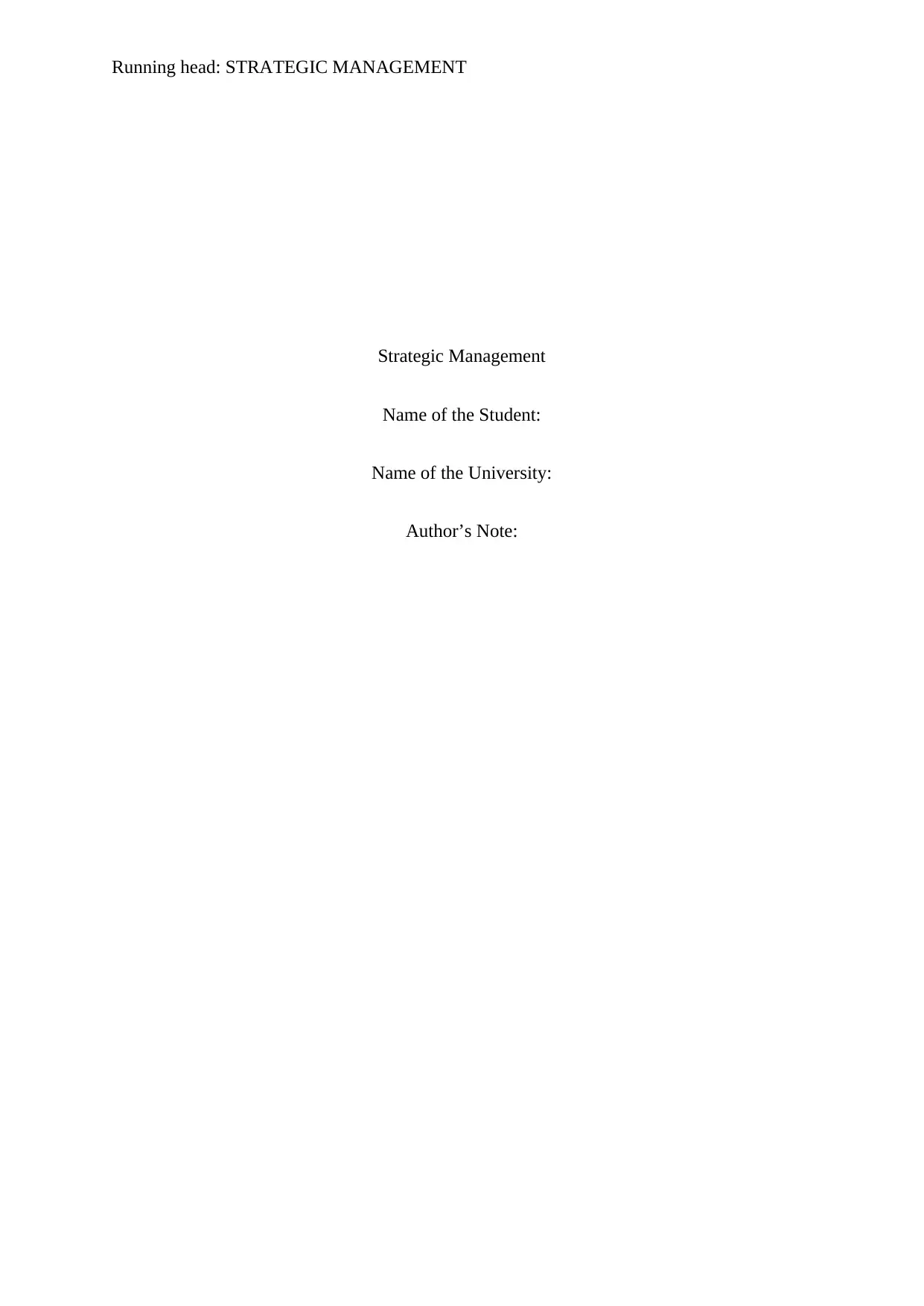
Running head: STRATEGIC MANAGEMENT
Strategic Management
Name of the Student:
Name of the University:
Author’s Note:
Strategic Management
Name of the Student:
Name of the University:
Author’s Note:
Paraphrase This Document
Need a fresh take? Get an instant paraphrase of this document with our AI Paraphraser
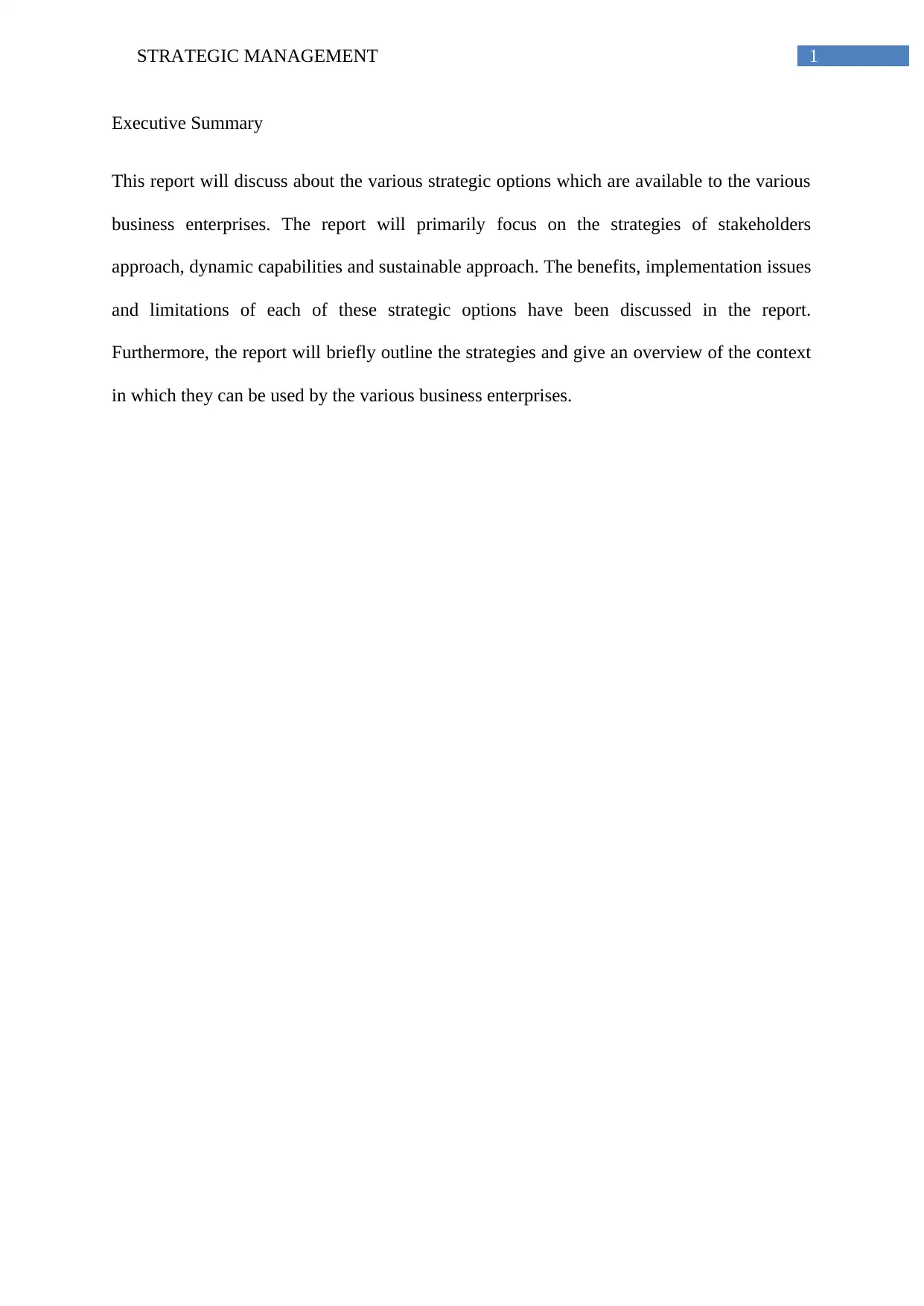
1STRATEGIC MANAGEMENT
Executive Summary
This report will discuss about the various strategic options which are available to the various
business enterprises. The report will primarily focus on the strategies of stakeholders
approach, dynamic capabilities and sustainable approach. The benefits, implementation issues
and limitations of each of these strategic options have been discussed in the report.
Furthermore, the report will briefly outline the strategies and give an overview of the context
in which they can be used by the various business enterprises.
Executive Summary
This report will discuss about the various strategic options which are available to the various
business enterprises. The report will primarily focus on the strategies of stakeholders
approach, dynamic capabilities and sustainable approach. The benefits, implementation issues
and limitations of each of these strategic options have been discussed in the report.
Furthermore, the report will briefly outline the strategies and give an overview of the context
in which they can be used by the various business enterprises.
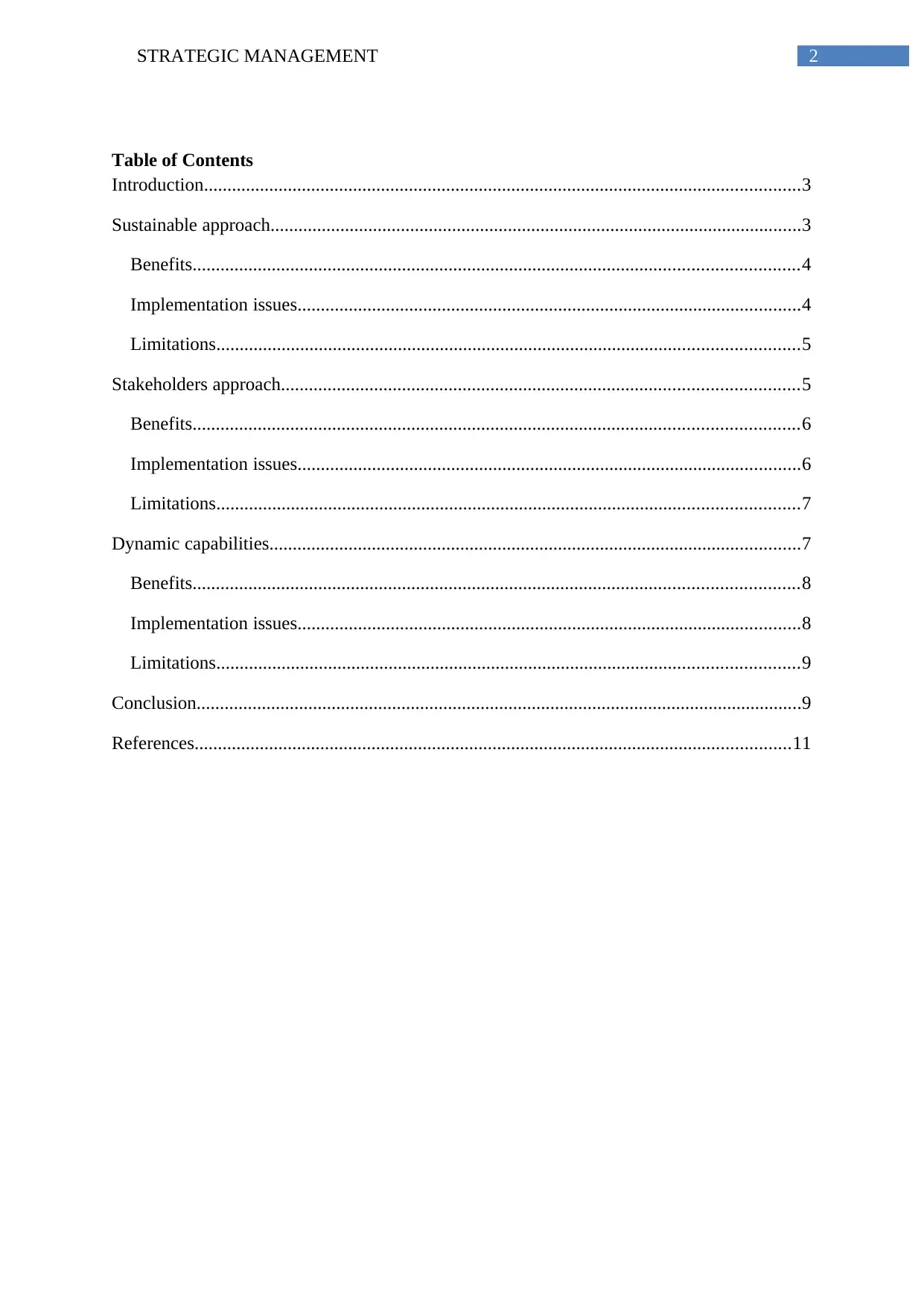
2STRATEGIC MANAGEMENT
Table of Contents
Introduction................................................................................................................................3
Sustainable approach..................................................................................................................3
Benefits..................................................................................................................................4
Implementation issues............................................................................................................4
Limitations.............................................................................................................................5
Stakeholders approach...............................................................................................................5
Benefits..................................................................................................................................6
Implementation issues............................................................................................................6
Limitations.............................................................................................................................7
Dynamic capabilities..................................................................................................................7
Benefits..................................................................................................................................8
Implementation issues............................................................................................................8
Limitations.............................................................................................................................9
Conclusion..................................................................................................................................9
References................................................................................................................................11
Table of Contents
Introduction................................................................................................................................3
Sustainable approach..................................................................................................................3
Benefits..................................................................................................................................4
Implementation issues............................................................................................................4
Limitations.............................................................................................................................5
Stakeholders approach...............................................................................................................5
Benefits..................................................................................................................................6
Implementation issues............................................................................................................6
Limitations.............................................................................................................................7
Dynamic capabilities..................................................................................................................7
Benefits..................................................................................................................................8
Implementation issues............................................................................................................8
Limitations.............................................................................................................................9
Conclusion..................................................................................................................................9
References................................................................................................................................11
⊘ This is a preview!⊘
Do you want full access?
Subscribe today to unlock all pages.

Trusted by 1+ million students worldwide
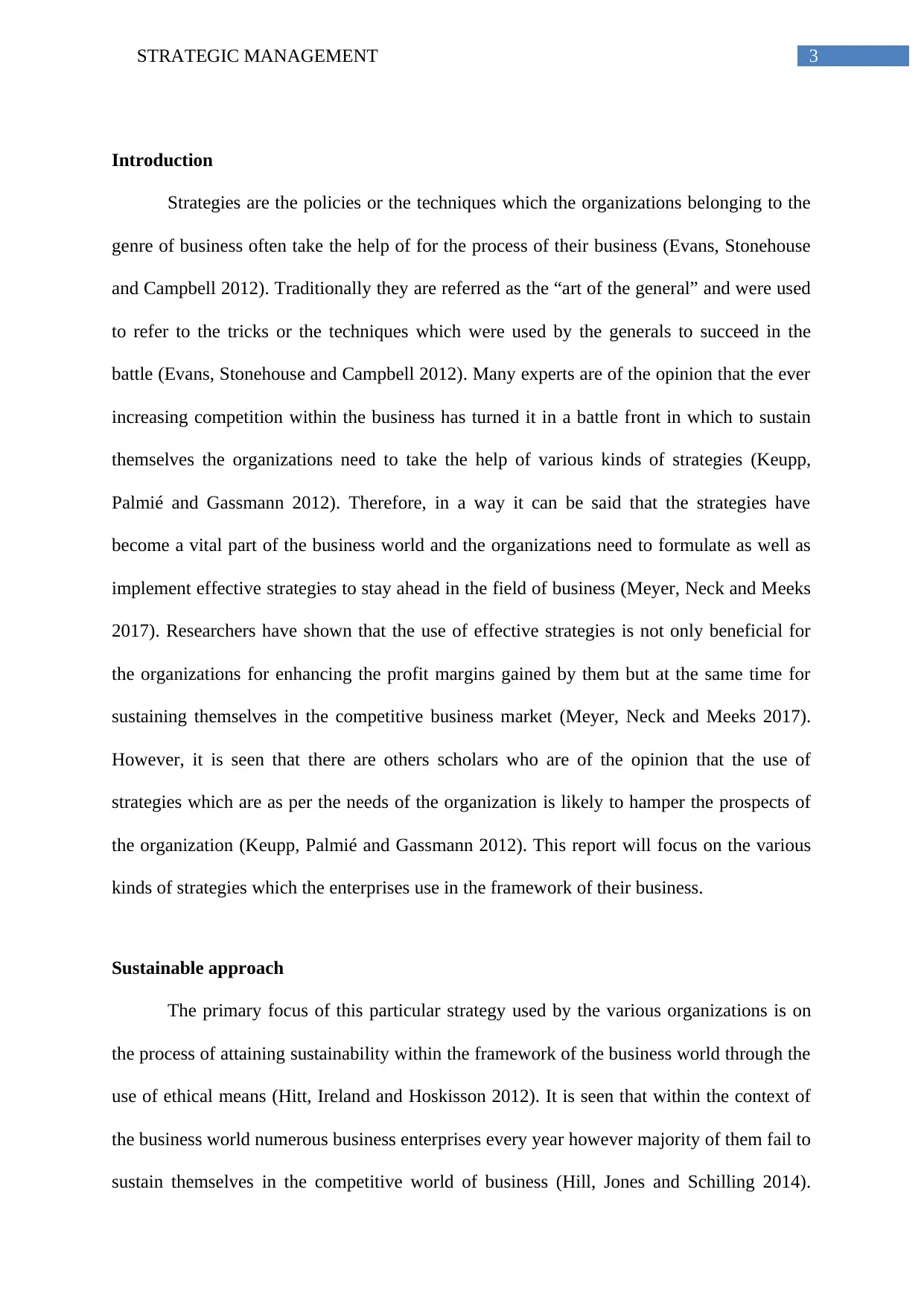
3STRATEGIC MANAGEMENT
Introduction
Strategies are the policies or the techniques which the organizations belonging to the
genre of business often take the help of for the process of their business (Evans, Stonehouse
and Campbell 2012). Traditionally they are referred as the “art of the general” and were used
to refer to the tricks or the techniques which were used by the generals to succeed in the
battle (Evans, Stonehouse and Campbell 2012). Many experts are of the opinion that the ever
increasing competition within the business has turned it in a battle front in which to sustain
themselves the organizations need to take the help of various kinds of strategies (Keupp,
Palmié and Gassmann 2012). Therefore, in a way it can be said that the strategies have
become a vital part of the business world and the organizations need to formulate as well as
implement effective strategies to stay ahead in the field of business (Meyer, Neck and Meeks
2017). Researchers have shown that the use of effective strategies is not only beneficial for
the organizations for enhancing the profit margins gained by them but at the same time for
sustaining themselves in the competitive business market (Meyer, Neck and Meeks 2017).
However, it is seen that there are others scholars who are of the opinion that the use of
strategies which are as per the needs of the organization is likely to hamper the prospects of
the organization (Keupp, Palmié and Gassmann 2012). This report will focus on the various
kinds of strategies which the enterprises use in the framework of their business.
Sustainable approach
The primary focus of this particular strategy used by the various organizations is on
the process of attaining sustainability within the framework of the business world through the
use of ethical means (Hitt, Ireland and Hoskisson 2012). It is seen that within the context of
the business world numerous business enterprises every year however majority of them fail to
sustain themselves in the competitive world of business (Hill, Jones and Schilling 2014).
Introduction
Strategies are the policies or the techniques which the organizations belonging to the
genre of business often take the help of for the process of their business (Evans, Stonehouse
and Campbell 2012). Traditionally they are referred as the “art of the general” and were used
to refer to the tricks or the techniques which were used by the generals to succeed in the
battle (Evans, Stonehouse and Campbell 2012). Many experts are of the opinion that the ever
increasing competition within the business has turned it in a battle front in which to sustain
themselves the organizations need to take the help of various kinds of strategies (Keupp,
Palmié and Gassmann 2012). Therefore, in a way it can be said that the strategies have
become a vital part of the business world and the organizations need to formulate as well as
implement effective strategies to stay ahead in the field of business (Meyer, Neck and Meeks
2017). Researchers have shown that the use of effective strategies is not only beneficial for
the organizations for enhancing the profit margins gained by them but at the same time for
sustaining themselves in the competitive business market (Meyer, Neck and Meeks 2017).
However, it is seen that there are others scholars who are of the opinion that the use of
strategies which are as per the needs of the organization is likely to hamper the prospects of
the organization (Keupp, Palmié and Gassmann 2012). This report will focus on the various
kinds of strategies which the enterprises use in the framework of their business.
Sustainable approach
The primary focus of this particular strategy used by the various organizations is on
the process of attaining sustainability within the framework of the business world through the
use of ethical means (Hitt, Ireland and Hoskisson 2012). It is seen that within the context of
the business world numerous business enterprises every year however majority of them fail to
sustain themselves in the competitive world of business (Hill, Jones and Schilling 2014).
Paraphrase This Document
Need a fresh take? Get an instant paraphrase of this document with our AI Paraphraser
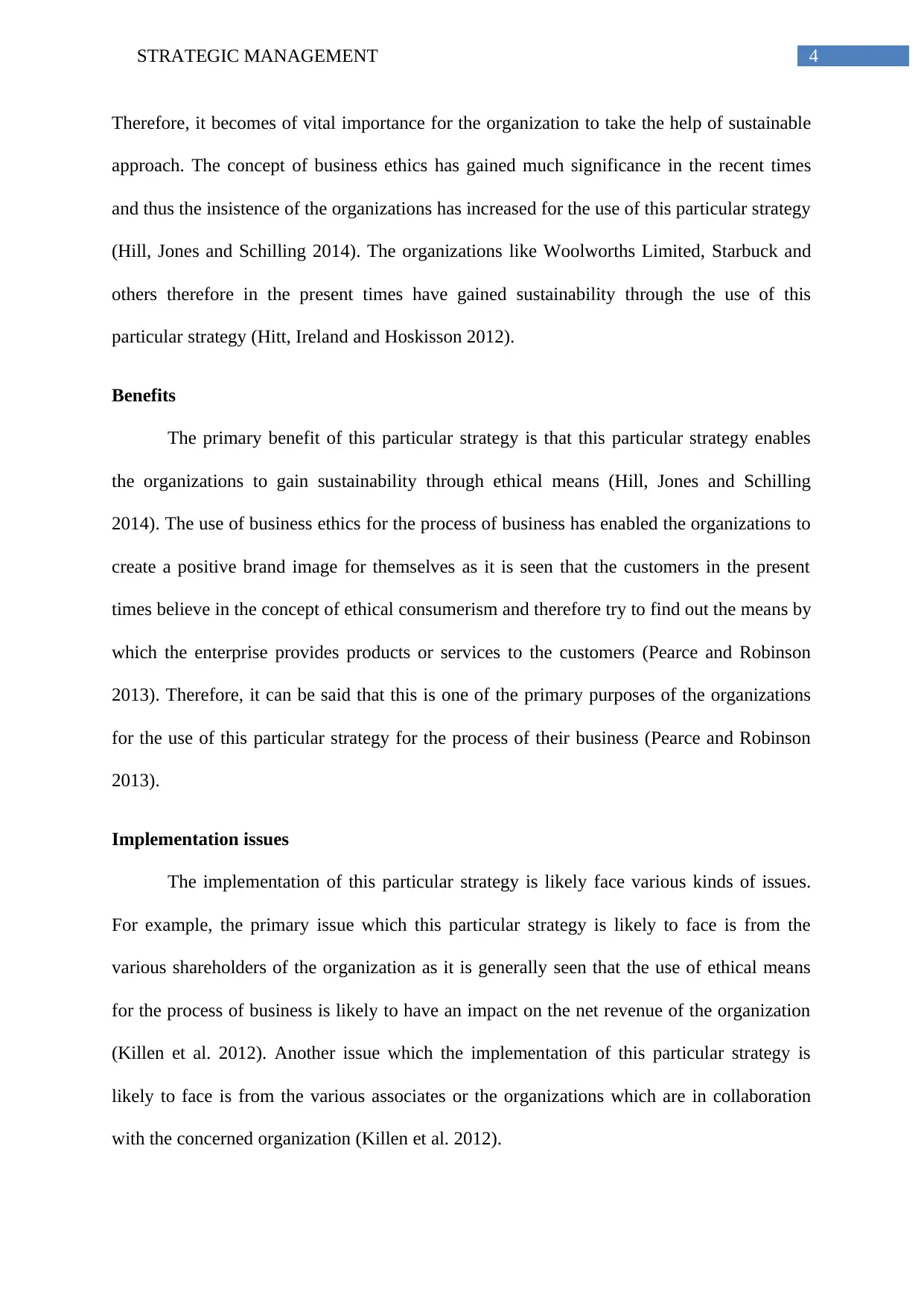
4STRATEGIC MANAGEMENT
Therefore, it becomes of vital importance for the organization to take the help of sustainable
approach. The concept of business ethics has gained much significance in the recent times
and thus the insistence of the organizations has increased for the use of this particular strategy
(Hill, Jones and Schilling 2014). The organizations like Woolworths Limited, Starbuck and
others therefore in the present times have gained sustainability through the use of this
particular strategy (Hitt, Ireland and Hoskisson 2012).
Benefits
The primary benefit of this particular strategy is that this particular strategy enables
the organizations to gain sustainability through ethical means (Hill, Jones and Schilling
2014). The use of business ethics for the process of business has enabled the organizations to
create a positive brand image for themselves as it is seen that the customers in the present
times believe in the concept of ethical consumerism and therefore try to find out the means by
which the enterprise provides products or services to the customers (Pearce and Robinson
2013). Therefore, it can be said that this is one of the primary purposes of the organizations
for the use of this particular strategy for the process of their business (Pearce and Robinson
2013).
Implementation issues
The implementation of this particular strategy is likely face various kinds of issues.
For example, the primary issue which this particular strategy is likely to face is from the
various shareholders of the organization as it is generally seen that the use of ethical means
for the process of business is likely to have an impact on the net revenue of the organization
(Killen et al. 2012). Another issue which the implementation of this particular strategy is
likely to face is from the various associates or the organizations which are in collaboration
with the concerned organization (Killen et al. 2012).
Therefore, it becomes of vital importance for the organization to take the help of sustainable
approach. The concept of business ethics has gained much significance in the recent times
and thus the insistence of the organizations has increased for the use of this particular strategy
(Hill, Jones and Schilling 2014). The organizations like Woolworths Limited, Starbuck and
others therefore in the present times have gained sustainability through the use of this
particular strategy (Hitt, Ireland and Hoskisson 2012).
Benefits
The primary benefit of this particular strategy is that this particular strategy enables
the organizations to gain sustainability through ethical means (Hill, Jones and Schilling
2014). The use of business ethics for the process of business has enabled the organizations to
create a positive brand image for themselves as it is seen that the customers in the present
times believe in the concept of ethical consumerism and therefore try to find out the means by
which the enterprise provides products or services to the customers (Pearce and Robinson
2013). Therefore, it can be said that this is one of the primary purposes of the organizations
for the use of this particular strategy for the process of their business (Pearce and Robinson
2013).
Implementation issues
The implementation of this particular strategy is likely face various kinds of issues.
For example, the primary issue which this particular strategy is likely to face is from the
various shareholders of the organization as it is generally seen that the use of ethical means
for the process of business is likely to have an impact on the net revenue of the organization
(Killen et al. 2012). Another issue which the implementation of this particular strategy is
likely to face is from the various associates or the organizations which are in collaboration
with the concerned organization (Killen et al. 2012).
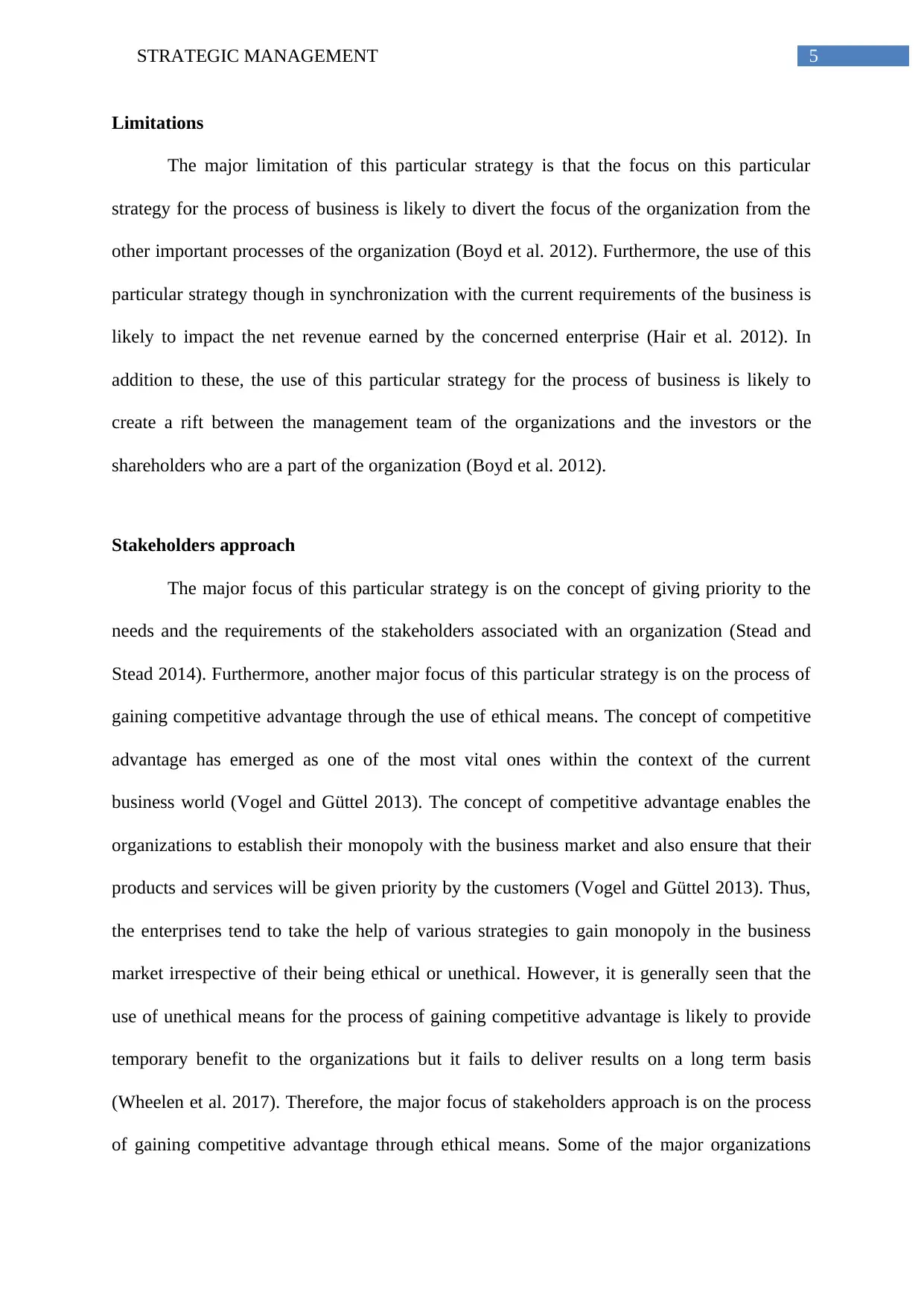
5STRATEGIC MANAGEMENT
Limitations
The major limitation of this particular strategy is that the focus on this particular
strategy for the process of business is likely to divert the focus of the organization from the
other important processes of the organization (Boyd et al. 2012). Furthermore, the use of this
particular strategy though in synchronization with the current requirements of the business is
likely to impact the net revenue earned by the concerned enterprise (Hair et al. 2012). In
addition to these, the use of this particular strategy for the process of business is likely to
create a rift between the management team of the organizations and the investors or the
shareholders who are a part of the organization (Boyd et al. 2012).
Stakeholders approach
The major focus of this particular strategy is on the concept of giving priority to the
needs and the requirements of the stakeholders associated with an organization (Stead and
Stead 2014). Furthermore, another major focus of this particular strategy is on the process of
gaining competitive advantage through the use of ethical means. The concept of competitive
advantage has emerged as one of the most vital ones within the context of the current
business world (Vogel and Güttel 2013). The concept of competitive advantage enables the
organizations to establish their monopoly with the business market and also ensure that their
products and services will be given priority by the customers (Vogel and Güttel 2013). Thus,
the enterprises tend to take the help of various strategies to gain monopoly in the business
market irrespective of their being ethical or unethical. However, it is generally seen that the
use of unethical means for the process of gaining competitive advantage is likely to provide
temporary benefit to the organizations but it fails to deliver results on a long term basis
(Wheelen et al. 2017). Therefore, the major focus of stakeholders approach is on the process
of gaining competitive advantage through ethical means. Some of the major organizations
Limitations
The major limitation of this particular strategy is that the focus on this particular
strategy for the process of business is likely to divert the focus of the organization from the
other important processes of the organization (Boyd et al. 2012). Furthermore, the use of this
particular strategy though in synchronization with the current requirements of the business is
likely to impact the net revenue earned by the concerned enterprise (Hair et al. 2012). In
addition to these, the use of this particular strategy for the process of business is likely to
create a rift between the management team of the organizations and the investors or the
shareholders who are a part of the organization (Boyd et al. 2012).
Stakeholders approach
The major focus of this particular strategy is on the concept of giving priority to the
needs and the requirements of the stakeholders associated with an organization (Stead and
Stead 2014). Furthermore, another major focus of this particular strategy is on the process of
gaining competitive advantage through the use of ethical means. The concept of competitive
advantage has emerged as one of the most vital ones within the context of the current
business world (Vogel and Güttel 2013). The concept of competitive advantage enables the
organizations to establish their monopoly with the business market and also ensure that their
products and services will be given priority by the customers (Vogel and Güttel 2013). Thus,
the enterprises tend to take the help of various strategies to gain monopoly in the business
market irrespective of their being ethical or unethical. However, it is generally seen that the
use of unethical means for the process of gaining competitive advantage is likely to provide
temporary benefit to the organizations but it fails to deliver results on a long term basis
(Wheelen et al. 2017). Therefore, the major focus of stakeholders approach is on the process
of gaining competitive advantage through ethical means. Some of the major organizations
⊘ This is a preview!⊘
Do you want full access?
Subscribe today to unlock all pages.

Trusted by 1+ million students worldwide
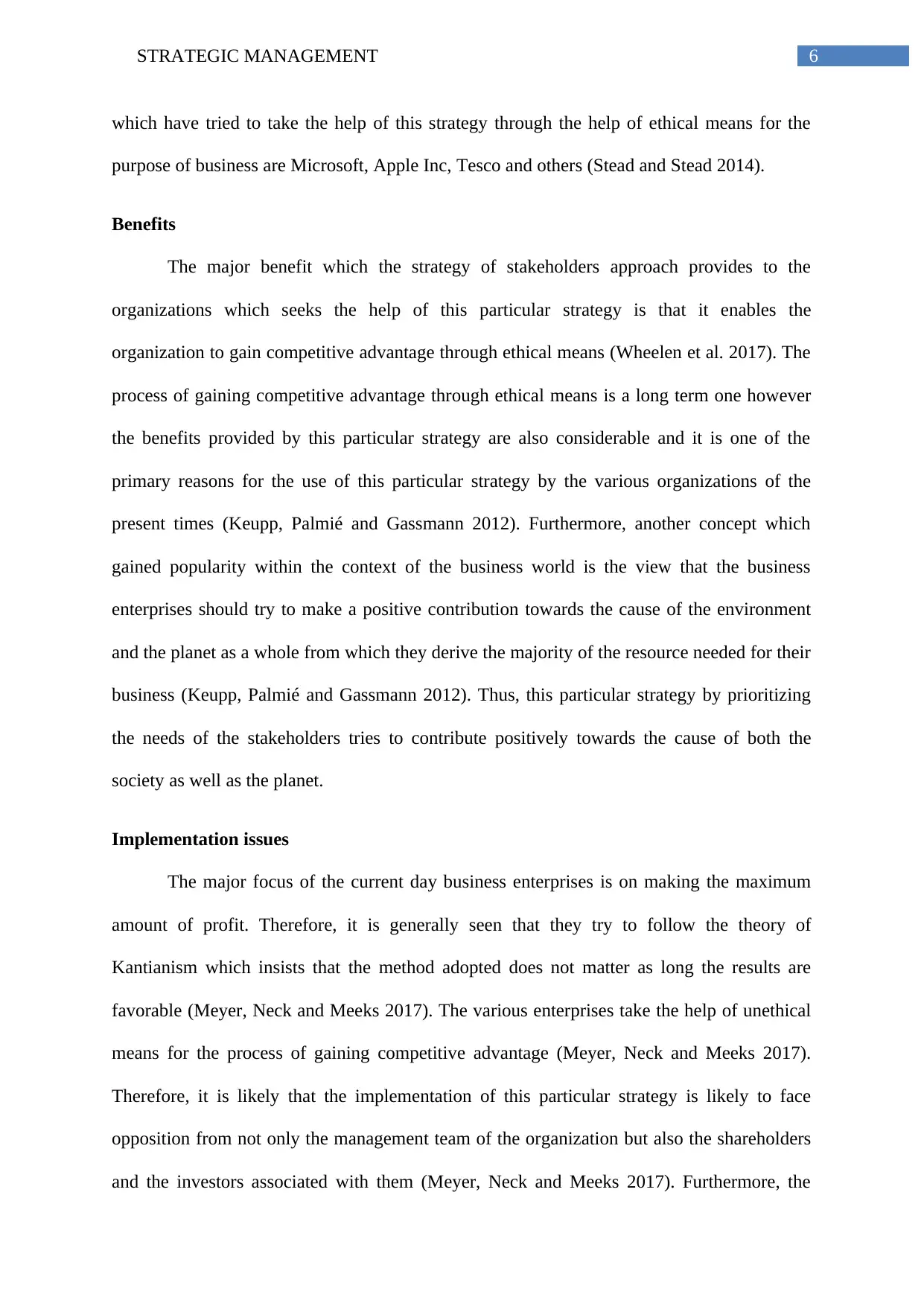
6STRATEGIC MANAGEMENT
which have tried to take the help of this strategy through the help of ethical means for the
purpose of business are Microsoft, Apple Inc, Tesco and others (Stead and Stead 2014).
Benefits
The major benefit which the strategy of stakeholders approach provides to the
organizations which seeks the help of this particular strategy is that it enables the
organization to gain competitive advantage through ethical means (Wheelen et al. 2017). The
process of gaining competitive advantage through ethical means is a long term one however
the benefits provided by this particular strategy are also considerable and it is one of the
primary reasons for the use of this particular strategy by the various organizations of the
present times (Keupp, Palmié and Gassmann 2012). Furthermore, another concept which
gained popularity within the context of the business world is the view that the business
enterprises should try to make a positive contribution towards the cause of the environment
and the planet as a whole from which they derive the majority of the resource needed for their
business (Keupp, Palmié and Gassmann 2012). Thus, this particular strategy by prioritizing
the needs of the stakeholders tries to contribute positively towards the cause of both the
society as well as the planet.
Implementation issues
The major focus of the current day business enterprises is on making the maximum
amount of profit. Therefore, it is generally seen that they try to follow the theory of
Kantianism which insists that the method adopted does not matter as long the results are
favorable (Meyer, Neck and Meeks 2017). The various enterprises take the help of unethical
means for the process of gaining competitive advantage (Meyer, Neck and Meeks 2017).
Therefore, it is likely that the implementation of this particular strategy is likely to face
opposition from not only the management team of the organization but also the shareholders
and the investors associated with them (Meyer, Neck and Meeks 2017). Furthermore, the
which have tried to take the help of this strategy through the help of ethical means for the
purpose of business are Microsoft, Apple Inc, Tesco and others (Stead and Stead 2014).
Benefits
The major benefit which the strategy of stakeholders approach provides to the
organizations which seeks the help of this particular strategy is that it enables the
organization to gain competitive advantage through ethical means (Wheelen et al. 2017). The
process of gaining competitive advantage through ethical means is a long term one however
the benefits provided by this particular strategy are also considerable and it is one of the
primary reasons for the use of this particular strategy by the various organizations of the
present times (Keupp, Palmié and Gassmann 2012). Furthermore, another concept which
gained popularity within the context of the business world is the view that the business
enterprises should try to make a positive contribution towards the cause of the environment
and the planet as a whole from which they derive the majority of the resource needed for their
business (Keupp, Palmié and Gassmann 2012). Thus, this particular strategy by prioritizing
the needs of the stakeholders tries to contribute positively towards the cause of both the
society as well as the planet.
Implementation issues
The major focus of the current day business enterprises is on making the maximum
amount of profit. Therefore, it is generally seen that they try to follow the theory of
Kantianism which insists that the method adopted does not matter as long the results are
favorable (Meyer, Neck and Meeks 2017). The various enterprises take the help of unethical
means for the process of gaining competitive advantage (Meyer, Neck and Meeks 2017).
Therefore, it is likely that the implementation of this particular strategy is likely to face
opposition from not only the management team of the organization but also the shareholders
and the investors associated with them (Meyer, Neck and Meeks 2017). Furthermore, the
Paraphrase This Document
Need a fresh take? Get an instant paraphrase of this document with our AI Paraphraser
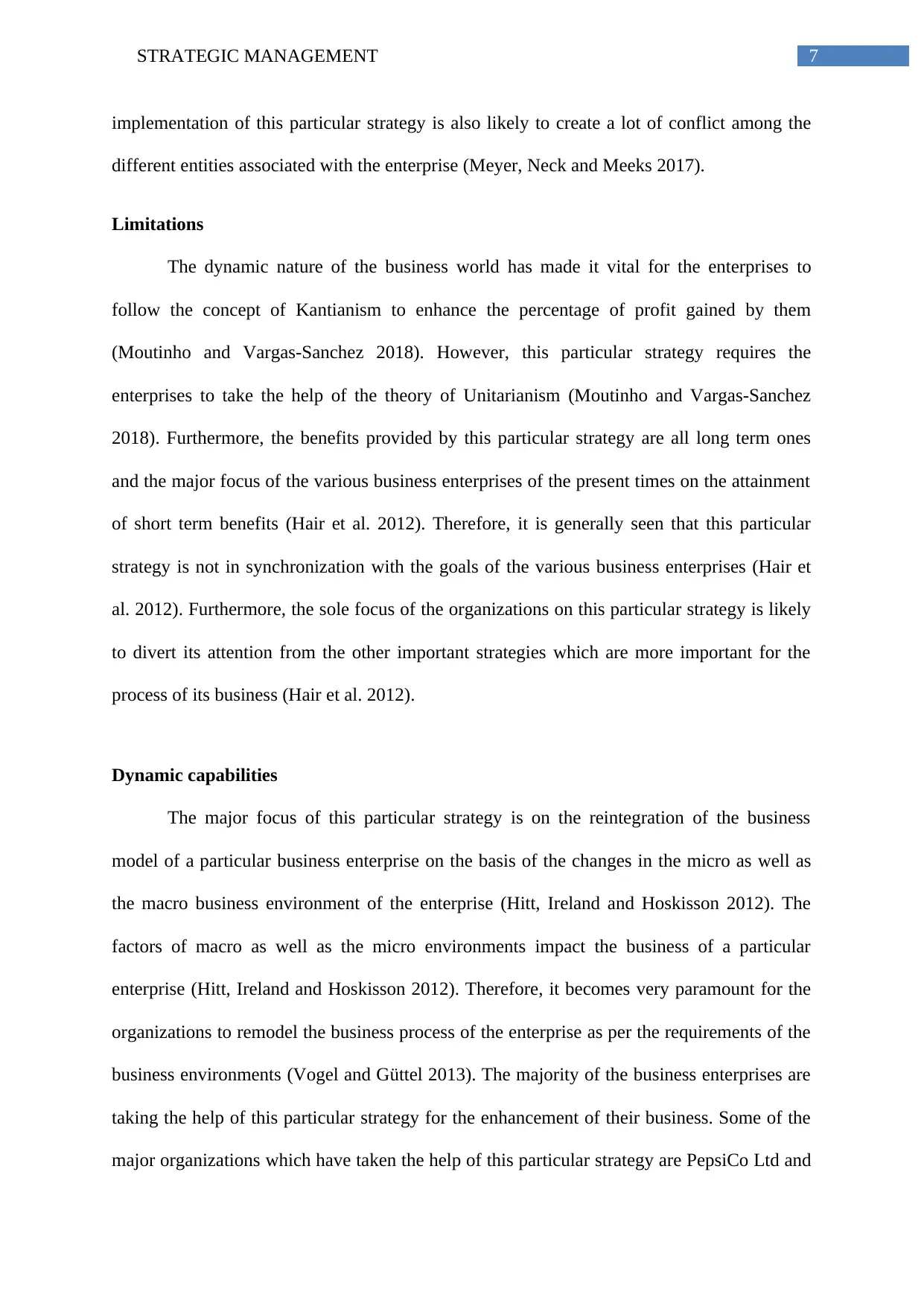
7STRATEGIC MANAGEMENT
implementation of this particular strategy is also likely to create a lot of conflict among the
different entities associated with the enterprise (Meyer, Neck and Meeks 2017).
Limitations
The dynamic nature of the business world has made it vital for the enterprises to
follow the concept of Kantianism to enhance the percentage of profit gained by them
(Moutinho and Vargas-Sanchez 2018). However, this particular strategy requires the
enterprises to take the help of the theory of Unitarianism (Moutinho and Vargas-Sanchez
2018). Furthermore, the benefits provided by this particular strategy are all long term ones
and the major focus of the various business enterprises of the present times on the attainment
of short term benefits (Hair et al. 2012). Therefore, it is generally seen that this particular
strategy is not in synchronization with the goals of the various business enterprises (Hair et
al. 2012). Furthermore, the sole focus of the organizations on this particular strategy is likely
to divert its attention from the other important strategies which are more important for the
process of its business (Hair et al. 2012).
Dynamic capabilities
The major focus of this particular strategy is on the reintegration of the business
model of a particular business enterprise on the basis of the changes in the micro as well as
the macro business environment of the enterprise (Hitt, Ireland and Hoskisson 2012). The
factors of macro as well as the micro environments impact the business of a particular
enterprise (Hitt, Ireland and Hoskisson 2012). Therefore, it becomes very paramount for the
organizations to remodel the business process of the enterprise as per the requirements of the
business environments (Vogel and Güttel 2013). The majority of the business enterprises are
taking the help of this particular strategy for the enhancement of their business. Some of the
major organizations which have taken the help of this particular strategy are PepsiCo Ltd and
implementation of this particular strategy is also likely to create a lot of conflict among the
different entities associated with the enterprise (Meyer, Neck and Meeks 2017).
Limitations
The dynamic nature of the business world has made it vital for the enterprises to
follow the concept of Kantianism to enhance the percentage of profit gained by them
(Moutinho and Vargas-Sanchez 2018). However, this particular strategy requires the
enterprises to take the help of the theory of Unitarianism (Moutinho and Vargas-Sanchez
2018). Furthermore, the benefits provided by this particular strategy are all long term ones
and the major focus of the various business enterprises of the present times on the attainment
of short term benefits (Hair et al. 2012). Therefore, it is generally seen that this particular
strategy is not in synchronization with the goals of the various business enterprises (Hair et
al. 2012). Furthermore, the sole focus of the organizations on this particular strategy is likely
to divert its attention from the other important strategies which are more important for the
process of its business (Hair et al. 2012).
Dynamic capabilities
The major focus of this particular strategy is on the reintegration of the business
model of a particular business enterprise on the basis of the changes in the micro as well as
the macro business environment of the enterprise (Hitt, Ireland and Hoskisson 2012). The
factors of macro as well as the micro environments impact the business of a particular
enterprise (Hitt, Ireland and Hoskisson 2012). Therefore, it becomes very paramount for the
organizations to remodel the business process of the enterprise as per the requirements of the
business environments (Vogel and Güttel 2013). The majority of the business enterprises are
taking the help of this particular strategy for the enhancement of their business. Some of the
major organizations which have taken the help of this particular strategy are PepsiCo Ltd and
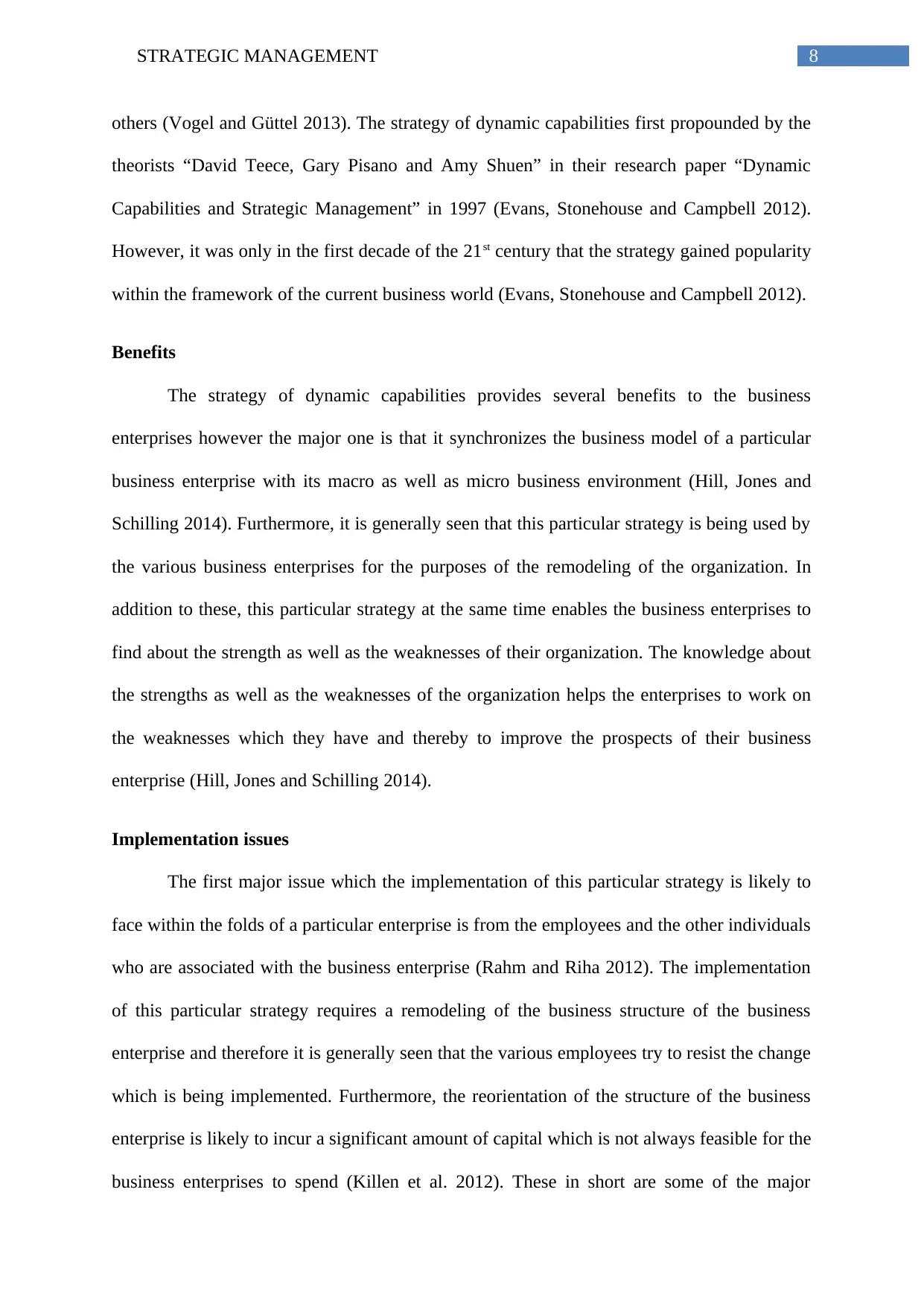
8STRATEGIC MANAGEMENT
others (Vogel and Güttel 2013). The strategy of dynamic capabilities first propounded by the
theorists “David Teece, Gary Pisano and Amy Shuen” in their research paper “Dynamic
Capabilities and Strategic Management” in 1997 (Evans, Stonehouse and Campbell 2012).
However, it was only in the first decade of the 21st century that the strategy gained popularity
within the framework of the current business world (Evans, Stonehouse and Campbell 2012).
Benefits
The strategy of dynamic capabilities provides several benefits to the business
enterprises however the major one is that it synchronizes the business model of a particular
business enterprise with its macro as well as micro business environment (Hill, Jones and
Schilling 2014). Furthermore, it is generally seen that this particular strategy is being used by
the various business enterprises for the purposes of the remodeling of the organization. In
addition to these, this particular strategy at the same time enables the business enterprises to
find about the strength as well as the weaknesses of their organization. The knowledge about
the strengths as well as the weaknesses of the organization helps the enterprises to work on
the weaknesses which they have and thereby to improve the prospects of their business
enterprise (Hill, Jones and Schilling 2014).
Implementation issues
The first major issue which the implementation of this particular strategy is likely to
face within the folds of a particular enterprise is from the employees and the other individuals
who are associated with the business enterprise (Rahm and Riha 2012). The implementation
of this particular strategy requires a remodeling of the business structure of the business
enterprise and therefore it is generally seen that the various employees try to resist the change
which is being implemented. Furthermore, the reorientation of the structure of the business
enterprise is likely to incur a significant amount of capital which is not always feasible for the
business enterprises to spend (Killen et al. 2012). These in short are some of the major
others (Vogel and Güttel 2013). The strategy of dynamic capabilities first propounded by the
theorists “David Teece, Gary Pisano and Amy Shuen” in their research paper “Dynamic
Capabilities and Strategic Management” in 1997 (Evans, Stonehouse and Campbell 2012).
However, it was only in the first decade of the 21st century that the strategy gained popularity
within the framework of the current business world (Evans, Stonehouse and Campbell 2012).
Benefits
The strategy of dynamic capabilities provides several benefits to the business
enterprises however the major one is that it synchronizes the business model of a particular
business enterprise with its macro as well as micro business environment (Hill, Jones and
Schilling 2014). Furthermore, it is generally seen that this particular strategy is being used by
the various business enterprises for the purposes of the remodeling of the organization. In
addition to these, this particular strategy at the same time enables the business enterprises to
find about the strength as well as the weaknesses of their organization. The knowledge about
the strengths as well as the weaknesses of the organization helps the enterprises to work on
the weaknesses which they have and thereby to improve the prospects of their business
enterprise (Hill, Jones and Schilling 2014).
Implementation issues
The first major issue which the implementation of this particular strategy is likely to
face within the folds of a particular enterprise is from the employees and the other individuals
who are associated with the business enterprise (Rahm and Riha 2012). The implementation
of this particular strategy requires a remodeling of the business structure of the business
enterprise and therefore it is generally seen that the various employees try to resist the change
which is being implemented. Furthermore, the reorientation of the structure of the business
enterprise is likely to incur a significant amount of capital which is not always feasible for the
business enterprises to spend (Killen et al. 2012). These in short are some of the major
⊘ This is a preview!⊘
Do you want full access?
Subscribe today to unlock all pages.

Trusted by 1+ million students worldwide
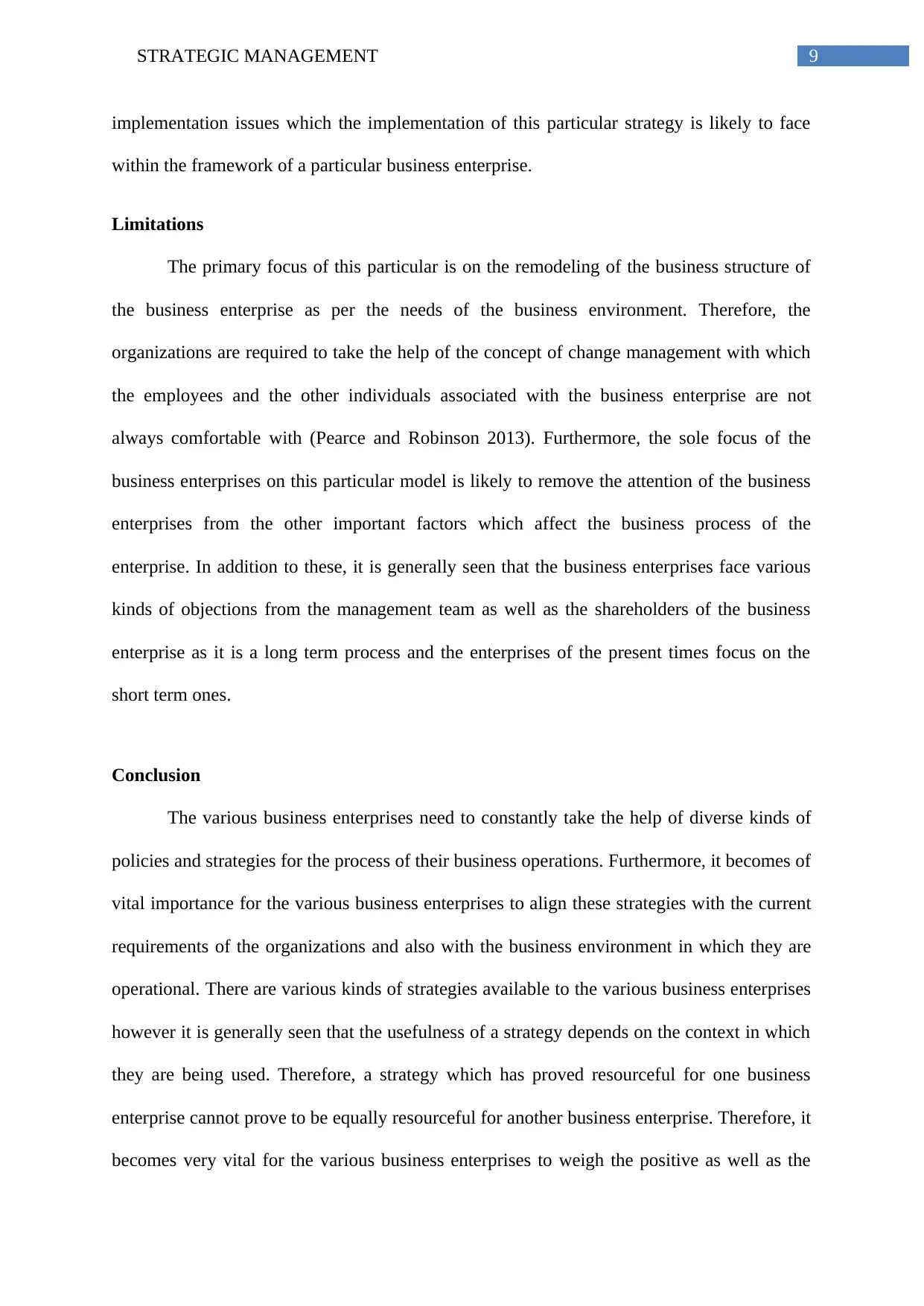
9STRATEGIC MANAGEMENT
implementation issues which the implementation of this particular strategy is likely to face
within the framework of a particular business enterprise.
Limitations
The primary focus of this particular is on the remodeling of the business structure of
the business enterprise as per the needs of the business environment. Therefore, the
organizations are required to take the help of the concept of change management with which
the employees and the other individuals associated with the business enterprise are not
always comfortable with (Pearce and Robinson 2013). Furthermore, the sole focus of the
business enterprises on this particular model is likely to remove the attention of the business
enterprises from the other important factors which affect the business process of the
enterprise. In addition to these, it is generally seen that the business enterprises face various
kinds of objections from the management team as well as the shareholders of the business
enterprise as it is a long term process and the enterprises of the present times focus on the
short term ones.
Conclusion
The various business enterprises need to constantly take the help of diverse kinds of
policies and strategies for the process of their business operations. Furthermore, it becomes of
vital importance for the various business enterprises to align these strategies with the current
requirements of the organizations and also with the business environment in which they are
operational. There are various kinds of strategies available to the various business enterprises
however it is generally seen that the usefulness of a strategy depends on the context in which
they are being used. Therefore, a strategy which has proved resourceful for one business
enterprise cannot prove to be equally resourceful for another business enterprise. Therefore, it
becomes very vital for the various business enterprises to weigh the positive as well as the
implementation issues which the implementation of this particular strategy is likely to face
within the framework of a particular business enterprise.
Limitations
The primary focus of this particular is on the remodeling of the business structure of
the business enterprise as per the needs of the business environment. Therefore, the
organizations are required to take the help of the concept of change management with which
the employees and the other individuals associated with the business enterprise are not
always comfortable with (Pearce and Robinson 2013). Furthermore, the sole focus of the
business enterprises on this particular model is likely to remove the attention of the business
enterprises from the other important factors which affect the business process of the
enterprise. In addition to these, it is generally seen that the business enterprises face various
kinds of objections from the management team as well as the shareholders of the business
enterprise as it is a long term process and the enterprises of the present times focus on the
short term ones.
Conclusion
The various business enterprises need to constantly take the help of diverse kinds of
policies and strategies for the process of their business operations. Furthermore, it becomes of
vital importance for the various business enterprises to align these strategies with the current
requirements of the organizations and also with the business environment in which they are
operational. There are various kinds of strategies available to the various business enterprises
however it is generally seen that the usefulness of a strategy depends on the context in which
they are being used. Therefore, a strategy which has proved resourceful for one business
enterprise cannot prove to be equally resourceful for another business enterprise. Therefore, it
becomes very vital for the various business enterprises to weigh the positive as well as the
Paraphrase This Document
Need a fresh take? Get an instant paraphrase of this document with our AI Paraphraser
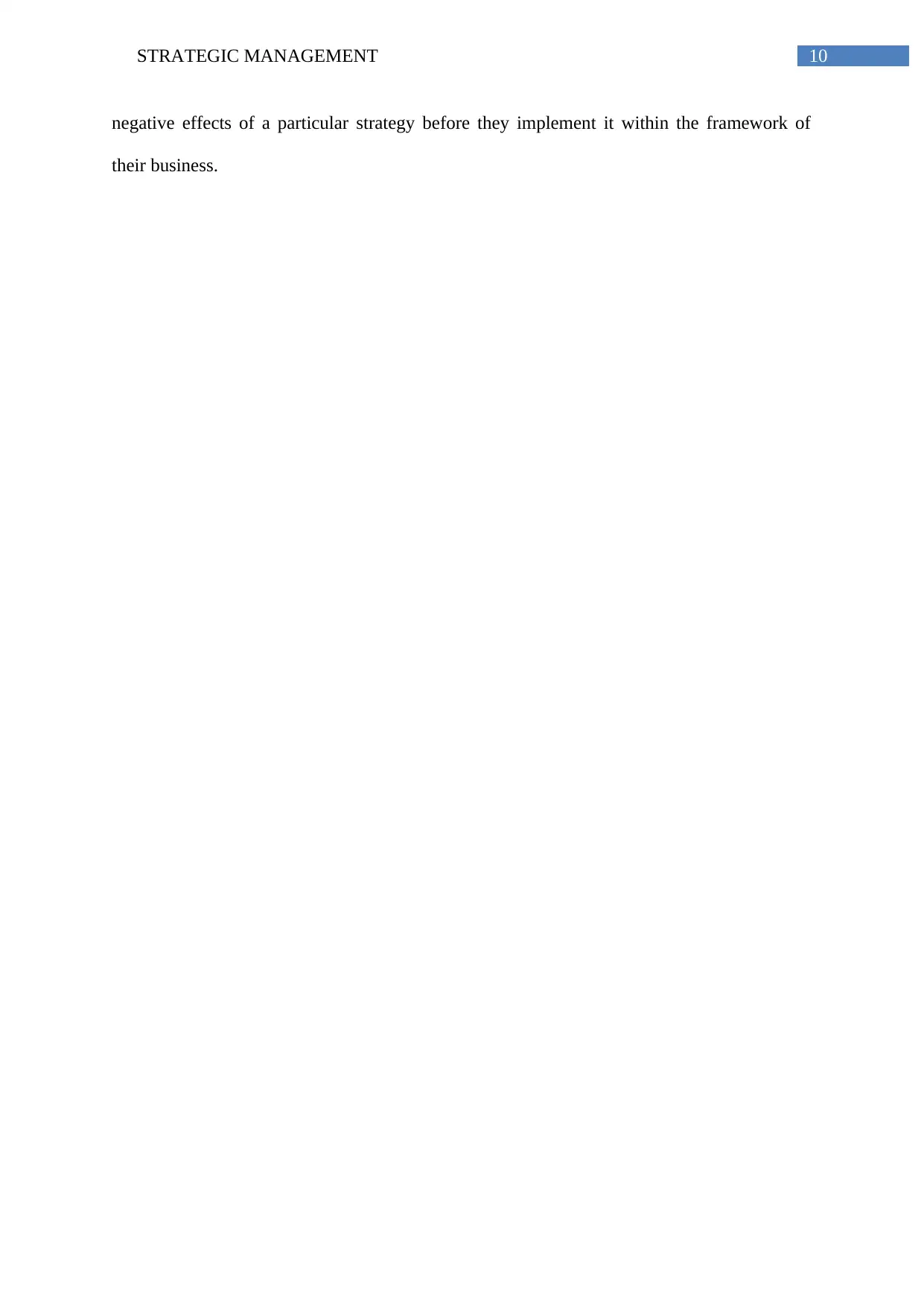
10STRATEGIC MANAGEMENT
negative effects of a particular strategy before they implement it within the framework of
their business.
negative effects of a particular strategy before they implement it within the framework of
their business.
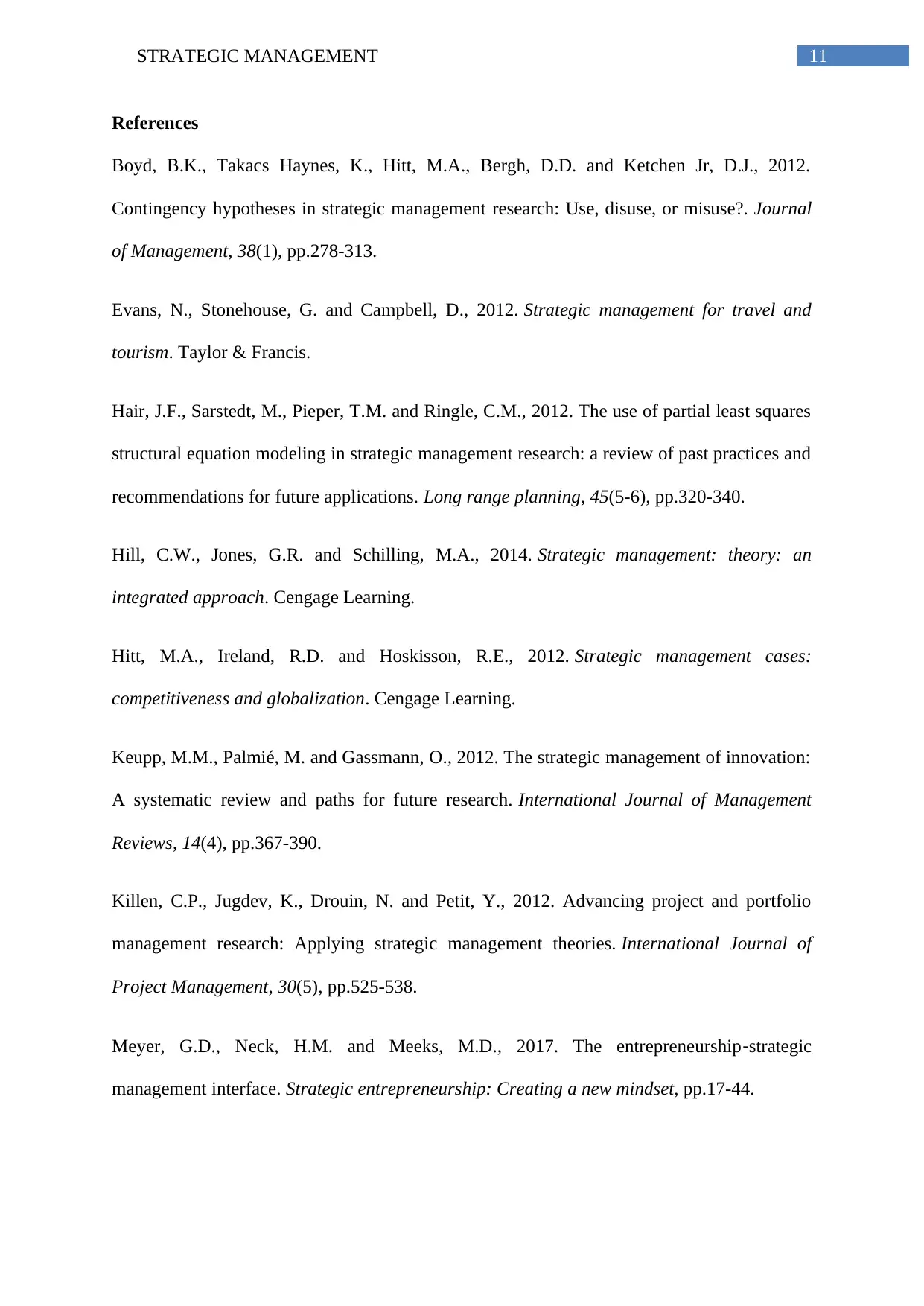
11STRATEGIC MANAGEMENT
References
Boyd, B.K., Takacs Haynes, K., Hitt, M.A., Bergh, D.D. and Ketchen Jr, D.J., 2012.
Contingency hypotheses in strategic management research: Use, disuse, or misuse?. Journal
of Management, 38(1), pp.278-313.
Evans, N., Stonehouse, G. and Campbell, D., 2012. Strategic management for travel and
tourism. Taylor & Francis.
Hair, J.F., Sarstedt, M., Pieper, T.M. and Ringle, C.M., 2012. The use of partial least squares
structural equation modeling in strategic management research: a review of past practices and
recommendations for future applications. Long range planning, 45(5-6), pp.320-340.
Hill, C.W., Jones, G.R. and Schilling, M.A., 2014. Strategic management: theory: an
integrated approach. Cengage Learning.
Hitt, M.A., Ireland, R.D. and Hoskisson, R.E., 2012. Strategic management cases:
competitiveness and globalization. Cengage Learning.
Keupp, M.M., Palmié, M. and Gassmann, O., 2012. The strategic management of innovation:
A systematic review and paths for future research. International Journal of Management
Reviews, 14(4), pp.367-390.
Killen, C.P., Jugdev, K., Drouin, N. and Petit, Y., 2012. Advancing project and portfolio
management research: Applying strategic management theories. International Journal of
Project Management, 30(5), pp.525-538.
Meyer, G.D., Neck, H.M. and Meeks, M.D., 2017. The entrepreneurship‐strategic
management interface. Strategic entrepreneurship: Creating a new mindset, pp.17-44.
References
Boyd, B.K., Takacs Haynes, K., Hitt, M.A., Bergh, D.D. and Ketchen Jr, D.J., 2012.
Contingency hypotheses in strategic management research: Use, disuse, or misuse?. Journal
of Management, 38(1), pp.278-313.
Evans, N., Stonehouse, G. and Campbell, D., 2012. Strategic management for travel and
tourism. Taylor & Francis.
Hair, J.F., Sarstedt, M., Pieper, T.M. and Ringle, C.M., 2012. The use of partial least squares
structural equation modeling in strategic management research: a review of past practices and
recommendations for future applications. Long range planning, 45(5-6), pp.320-340.
Hill, C.W., Jones, G.R. and Schilling, M.A., 2014. Strategic management: theory: an
integrated approach. Cengage Learning.
Hitt, M.A., Ireland, R.D. and Hoskisson, R.E., 2012. Strategic management cases:
competitiveness and globalization. Cengage Learning.
Keupp, M.M., Palmié, M. and Gassmann, O., 2012. The strategic management of innovation:
A systematic review and paths for future research. International Journal of Management
Reviews, 14(4), pp.367-390.
Killen, C.P., Jugdev, K., Drouin, N. and Petit, Y., 2012. Advancing project and portfolio
management research: Applying strategic management theories. International Journal of
Project Management, 30(5), pp.525-538.
Meyer, G.D., Neck, H.M. and Meeks, M.D., 2017. The entrepreneurship‐strategic
management interface. Strategic entrepreneurship: Creating a new mindset, pp.17-44.
⊘ This is a preview!⊘
Do you want full access?
Subscribe today to unlock all pages.

Trusted by 1+ million students worldwide
1 out of 13
Related Documents
Your All-in-One AI-Powered Toolkit for Academic Success.
+13062052269
info@desklib.com
Available 24*7 on WhatsApp / Email
![[object Object]](/_next/static/media/star-bottom.7253800d.svg)
Unlock your academic potential
Copyright © 2020–2025 A2Z Services. All Rights Reserved. Developed and managed by ZUCOL.





